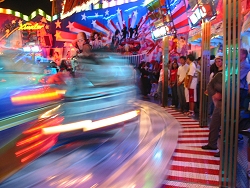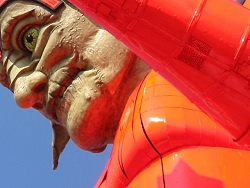|
.
This sense
of manic hysteria isn’t simply confined to the time you spend in your
seat. The mere practicalities of loading and unloading a ride provides
moments that will leave the theme park fan open-mouthed. It is well
known that fairground crews can operate coasters with phenomenal
efficiency.
Coasters
like EuroStar and Olympia Looping are capable of operating four or even
five trains at peak times, keeping capacity sky-high, while the
gargantuan Wildwasser 3 Log Flume operates with such breathtaking
swiftness that the queue keeps moving at a speed that approaches normal
walking pace. Slow loading means longer queues, and longer queues mean
fewer ticket sales, therefore nothing is allowed to slow operations for
an instant.
Better
still are the loading procedures for the spin rides. A busy night on a
Top Scan, for example, will see all 30 new riders sorted into groups and
standing on the platform ready to board before the pods have even been
lowered into position.
If this
sounds a trifle risky, then the unabashed mania of a busy Break Dance is
quite simply awesome, with punters gathering at the edge of the ride,
token in hand, as the ride slows, then surging onto the platform as soon
as they feel capable of remaining on their feet. For a few seconds,
everyone battles it out for seats, while staff frenziedly collect tokens
from the successful. A hooter sounds, and the ride gets started while
the last of the losers are still running to safety.
|

|
| Spot
the fence. |
It may not
be exactly civilised, nor is it what the Health and Safety Executive
would advise, but it’s the only ride on Earth where you can get an
adrenalin rush merely from trying to get a seat. For any cynics who
doubt the efficiency of these methods, suffice to say that a 48-seater
Breakdance can be loaded in little over ten seconds.
The
liberating thing about such rides is that, despite the frenzied
atmosphere, the showmen clearly trust the punters not to do anything too
silly. Better still, riders react accordingly and accept the need to
look after themselves, while maintaining the all-important sense of
urgency.
While theme
parks (understandably) work on the basis that people will always do
something moronically stupid if they are given half a chance, there is
something truly invigorating about being trusted to stand casually
around a speeding ride without needing to be being fenced in, or being
told when it is safe to hop onto the platform.
If someone
is overly-optimistic, jumps aboard too early and takes a fall, there’s
no Health & Safety enquiry, and no call to Claims Direct, they just
get back up and carry on hunting a seat. No nanny-state here, you’re
responsible for your own actions, just how things should be.
Of course,
this would all mean nothing if the rides themselves weren’t up to
scratch. Fortunately, this isn’t a problem. For all the conflicting
demands placed upon their design, the coasters that have graced the
German fair circuit, such as Thriller, Dreier Looping, Olympia Looping,
and EuroStar, are among the finest ever built, and are certainly four of
the wildest and most intense coasters you could ever hope to ride.
No less
impressive is Star World, the vast enclosed family coaster that
pre-dated the current craze for spinning coasters, and boasts a façade
that is quite simply mind-blowing, featuring the enormous Galaktos, a
fully animated alien robot clad in his outsize day-glo orange space
suit, whose sole purpose in life is to lure in the punters. Such
extravagance would be commendable from a theme park ride, but from a
travelling ride it is astounding.
However,
let’s not waste time talking about roller coasters. They may be
generally regarded as the “King of the amusement park”, but on the
fairground it is the spin ride that undoubtedly bears the crown. A visit
to a major fair will undoubtedly reveal a multitude of rides that will
be completely unknown to the average theme park fan, as almost
everything from the major spin ride manufacturers appears on the fairs
first, before eventually making it into the parks. The supremacy of the
spin ride is perfectly justified, for despite the world-class quality of
many travelling coasters, there is not a coaster on Earth can compare to
the sheer fun and thrill of a well-run spin ride.
|

|
| Coasters
are hardly candid, either, yet they're not king of the fair |
There will
no doubt be those who scoff at the idea that a good spin ride is
superior to a roller coaster, so allow me to present my case. Ride a
roller coaster, and you always know what you’re going to get. However
ingenious the design may be, the train will always perform the same
actions in the same order, no matter how many times you ride. You know
perfectly well that whatever happens for the 2 or 3 minutes you are in
motion, somebody somewhere has scripted it all out in the tiniest detail
detail.
With a spin
ride, this is not the case. Ideally, the ride will be run manually,
meaning that not even the operator is entirely sure how long the ride
will last, or what manoeuvres you are going to perform. In many cases,
not even the operator has total control, as your seat will quite often
be spinning and flipping under the sole jurisdiction of Sir Isaac
Newton. There is nothing in life more invigorating than a bit of
spontaneity, and this where a good spin ride lands a winning blow
against all other types of ride.
Combine
this spontaneity with the usual fairground melee of music, lighting and
special effects (all of which are likely to be different every time you
ride), and you have a level of euphoric mayhem that is unrivalled
elsewhere.
Continues...
|